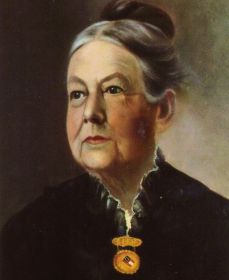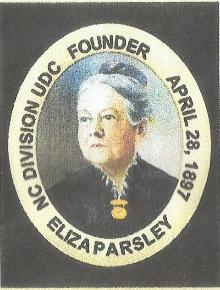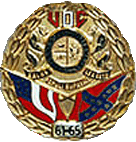Division History
The North Carolina Division United Daughters of the Confederacy was organized by Mrs. William M. Parsley who had heard that there was such an organization in Nashville, Tennessee called the United Daughters of the Confederacy. She had been thinking about forming a similar organization of the ladies of Wilmington, so she immediately sought information on how to begin such an organization in North Carolina. Her inquiry was answered by Mrs. Anna Davenport Raines, head of the Work in Georgia, who urged her to apply for a charter with the authority to form chapters. Mrs. Parsley called a meeting on 27 December 1894. Twenty four women signed applications. They received their charter and organized with fifty plus members. Upon discovering that only lineal descendants were eligible, wives, mothers and sisters were eliminated. This was most distressful to the ladies, so Mrs. Parsley determined to attend the next meeting in Nashville, Tennessee on 30 March 1894 to bring this matter before the Convention. As a result the constitutional clause on eligibility was amended. On her return home, the North Carolina Division of the United Daughters of the Confederacy was officially organized on 28 April 1897 with Mrs. Parsley as President and Miss Kate McKimmon (Raleigh) as Recording Secretary. The first State Convention was held in Wilmington on 3 October 1897 with representatives from six chapters in attendance. At this convention the Constitution for the Division was formally adopted.


Eliza Hall Nutt (Hallie) Parsley was born in Wilmington, the daughter of Louise and Henry Nutt. She was educated at St. Mary’s School in Raleigh. On 2 Sept. 1862 she married William Murdock Parsley, a captain in the Confederate army. He was wounded three times during the war and was sent home to recuperate. Near Richmond, Va., a few days before the surrender at Appomattox, by then a lieutenant colonel, he was fatally wounded. Mrs. Parsley and their two young daughters, Amanda and Janie, were then refuging at Sleepy Hollow in Bladen County but soon returned to Wilmington. There she spent the remainder of her life, supporting herself and her daughters by teaching. In 1894 she opened her own school for small children at 619 Orange Street. During the war Hallie Parsley had been occupied in caring for wounded soldiers and in offering what comfort she could to suffering friends and neighbors. After the war she continued her service to others, largely through the Confederate Memorial Association of Wilmington. Among other things, the members undertook to decorate the graves of the seven hundred Confederate dead there. There were similar organizations elsewhere in the state and the members learned of the United Daughters of the Confederacy that had been established in other states. Mrs. Parsley was named chairman of a committee to inquire about the purpose of this body, and from the original chapter in Nashville, Tenn., she received information, a charter, and authority to establish units in North Carolina. In December 1894 she organized the Cape Fear Chapter of the UDC, and in April 1897 she formed the UDC’s North Carolina Division. Mrs. Parsley was the Division’s first president, a post she held for two years. She soon became a public figure, advising women who wanted to create new chapters, traveling frequently throughout the state and elsewhere on behalf of the UDC. Her goal was to inspire love for the Southern states and to teach that Southern soldiers were heroes and not traitors. “In her speeches,” it was said, “her soft voice was always animated by the love and devotion in her heart to the young soldier-husband who did not return.” She also was involved in arranging the production of amateur plays, pageants, and musicals in Wilmington in the 1890s. Mrs. Parsley spent her final years at her home on Red Cross Street, Wilmington, receiving friends and admirers. It was said that, like countless Confederate widows, she always dressed in black, her straight hair parted in the middle and combed back. When out of doors she wore a small black bonnet with a long crepe veil at the back.
